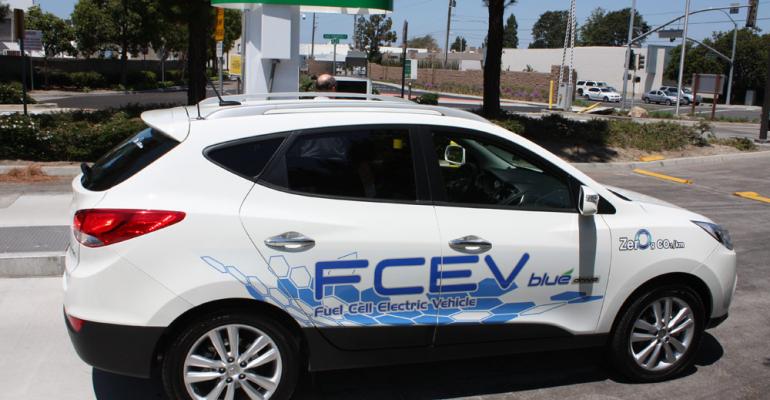LOS ANGELES – In 2006, General Motors began building a network of hydrogen refueling stations to speed up research into what was needed to make fuel-cell vehicles a commercial reality. A few still are operating, including one near Los Angeles International Airport.
Charlie Freese, executive director-global fuel-cell activities at GM, checks on it every time he passes through the huge airport. But GM isn’t in the refueling station business, he says.
“This is different from going out and building a network,” says Freese. “Somebody has to step up and do that.”
Fuel-cell vehicles have been dangled as the ideal zero-emissions solution for years. Range anxiety? Unlike battery-electrics, fuel-cell vehicles can be refilled at a station just like a gasoline-powered car.
But hurdles remain. The vehicles still are expensive, and an even larger issue is the lack of a refueling infrastructure.
Recently, auto makers have been banding together to solve both problems, though widespread availability of FCVs remains years away.
“It is always a running joke that fuel-cell vehicles are just 10 years away,” says Mike Omotoso, senior manager-global powertrain at LMC Automotive. “Now we are looking at another five to 10 years.”
LMC forecasts global FCV sales of only 20,000 units in 10 years. However, there is more impetus to commercialize FCVs now because of tougher emissions standards taking effect in the U.S. and Europe, Omotoso says.
Auto makers are forming partnerships to cut development costs and expand infrastructure, and many already have put FCVs on the road.
In the past year, separate agreements have been signed by GM and Honda; Toyota and BMW; and Ford, Daimler and Nissan to work together to produce hydrogen FCVs.
GM and Honda aim to have a jointly developed FCV on the market by 2020. Toyota and BMW are targeting a fuel-cell system within the same timeframe, and Ford, Daimler and Nissan have set 2017 for a mass-market FCV launch.
GM and Honda believe their cooperation is the most promising because the two auto makers hold the most FCV patents. With the FCX Clarity, launched in 2007, Honda was first to offer a “purchasable” vehicle, Freese notes. “They have gone a long way to stretching the envelope in manufacturing to make fuel-cell vehicles in volume.”
Robert Bienenfeld, senior manager-environment and energy strategy at American Honda repays the complement. “We have a lot of respect for (GM’s) expertise in chemistry,” he says.
The auto makers will consolidate suppliers, boosting volume and cutting costs through joint sourcing.
“Everything in this industry depends on volume, (and) everything in the alternative-fuel world works against volume,” Bienenfeld says.
Not all auto makers are partnering. Hyundai is going it alone with its Tucson cross/utility FCV launched this year in Europe, where it is available for lease. Assembled in Korea, Hyundai is trying to divert some production to the U.S. beginning next year, says Gil Castillo, senior group manager-alternative vehicle strategy at Hyundai Motor America.
By 2016, when its next-generation FCV is due, Hyundai aims to produce tens of thousands and reduce the vehicle’s price 40%, Castillo says.
“A lot of the cost is associated with the numbers of units being produced,” he says.
Materials used in FCVs also are pricey, and Hyundai is working on lessening the amount of heavy metals required by the fuel stack, Castillo says.
Freese says GM is working to cut the platinum used from 3.2 oz. (90 g) to just 0.4 oz. (10 g) and trim the number of injectors in the fuel system from seven to one.
“We have a bead on taking a lot of that cost out,” he says.
That means vehicle prices should drop. But widespread use of FCVs is as much about fueling infrastructure as it is about the vehicle, and here progress is slow.
Even California, which has an official roadmapto expand its fuel-cell infrastructure, has only a handful of refueling stations. In addition to the cost of the stations themselves, there are irritating regulatory issues that create other hurdles.
For example, existing stations can’t charge for the hydrogen, because California hasn’t set out rules for certifying the equipment and metering how much hydrogen is pumped. By state law, the cost of developing those rules must be paid for by charging fees on hydrogen dispensed. But no retail hydrogen is being dispensed, so no fees are being earned. And the state can’t use fees collected for dispensing gasoline and diesel.
“It is a catch-22,” Bienenfeld says. “You can’t use fees on anything but what generated them.” H2USA, a national group advocating for hydrogen, is lobbying the Department of Energy for funding to pay for certification and metering guidelines, he says.
The California Energy Commission earlier this month awarded Hydrogen Frontier a $3 million grant to build a hydrogen-fueling station at a Hyundai America Technical Center testing facility. Plans are for completion in October 2014, with the facility open to the public.
Expanded use of natural gas as a vehicle fuel could help grow hydrogen infrastructure, says Jim Saber, vice president-business and technology development at NextEnergy in Detroit.
A nonprofit aimed at boosting advanced-energy investment, NextEnergy is working with Chrysler and GM to get the DOE to develop standards for hydrogen use, he says.
Hydrogen can be produced from natural gas, and a station set up to dispense natural gas can more easily add hydrogen storage, says Saber.
“I would be pretty confident to say that a wider adoption of natural-gas vehicles would accelerate the movement of hydrogen-fuel-cell vehicles,” he says.
Navigant Research forecasts low tens of thousands of FCVs on North American roads through 2020.
“After 2020, you should see larger volumes as infrastructure has been put in place, and vehicle prices should come down due to economies of scale,” predicts Lisa Jerram, senior research analyst at Navigant.





